Business Environment Report: Organizational Functions and Objectives
VerifiedAdded on 2023/06/05
|11
|3032
|135
Report
AI Summary
This report provides an in-depth analysis of the business environment, focusing on different types of organizations (public, private, and voluntary sectors) and their legal structures. It examines the size and scope of various organizations like BBC, Marks and Spencer, and Oxfam, detailing their vision, mission, and stakeholders. The report also explains the relationship between different organizational functions and how they link to organizational objectives and structure, recommending a divisional structure for Marks and Spencer due to its diverse product range. The analysis identifies the importance of aligning organizational structure with business objectives to achieve efficiency and effectiveness. Desklib offers a platform for students to access similar reports and study tools to further their understanding of business environments and organizational structures.
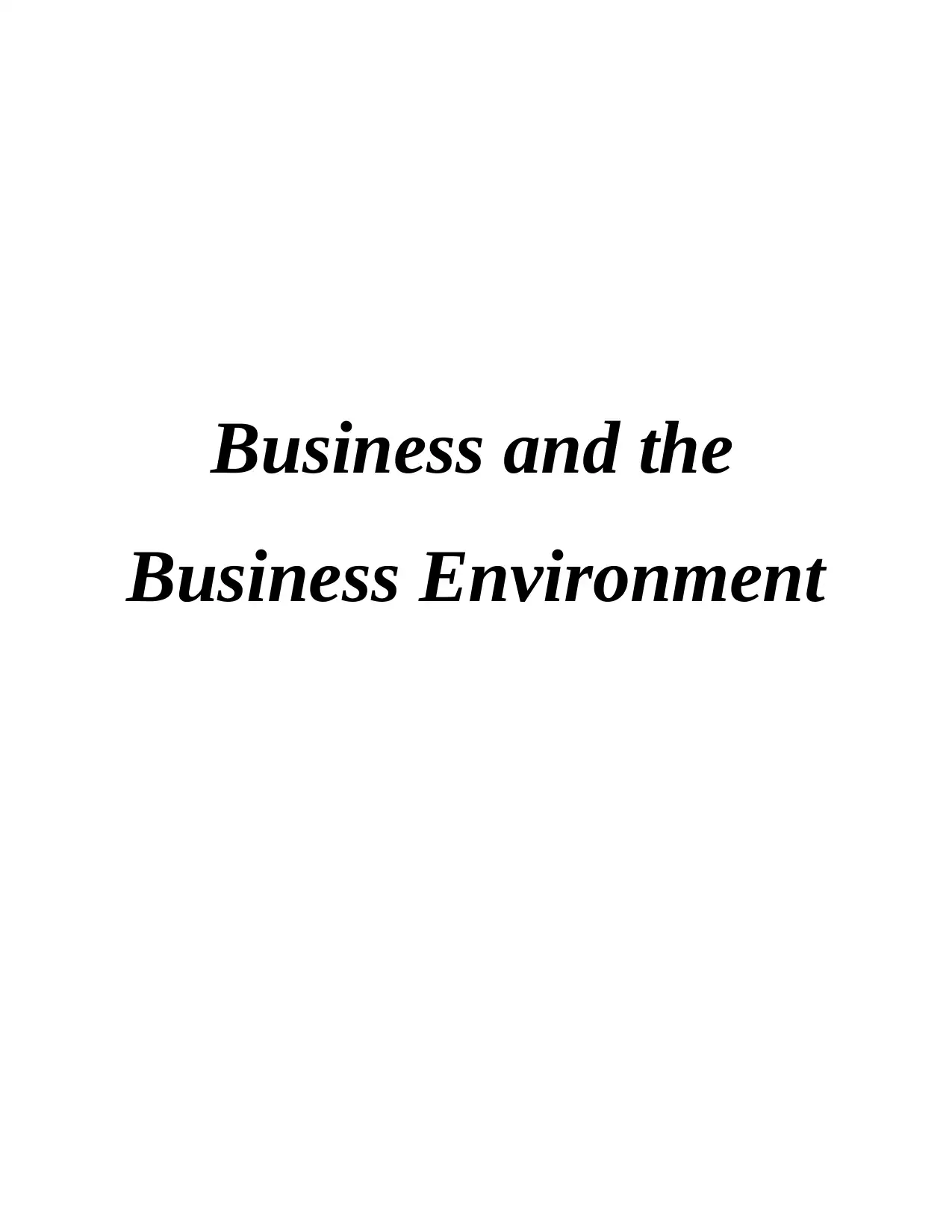
Business and the
Business Environment
Business Environment
Paraphrase This Document
Need a fresh take? Get an instant paraphrase of this document with our AI Paraphraser
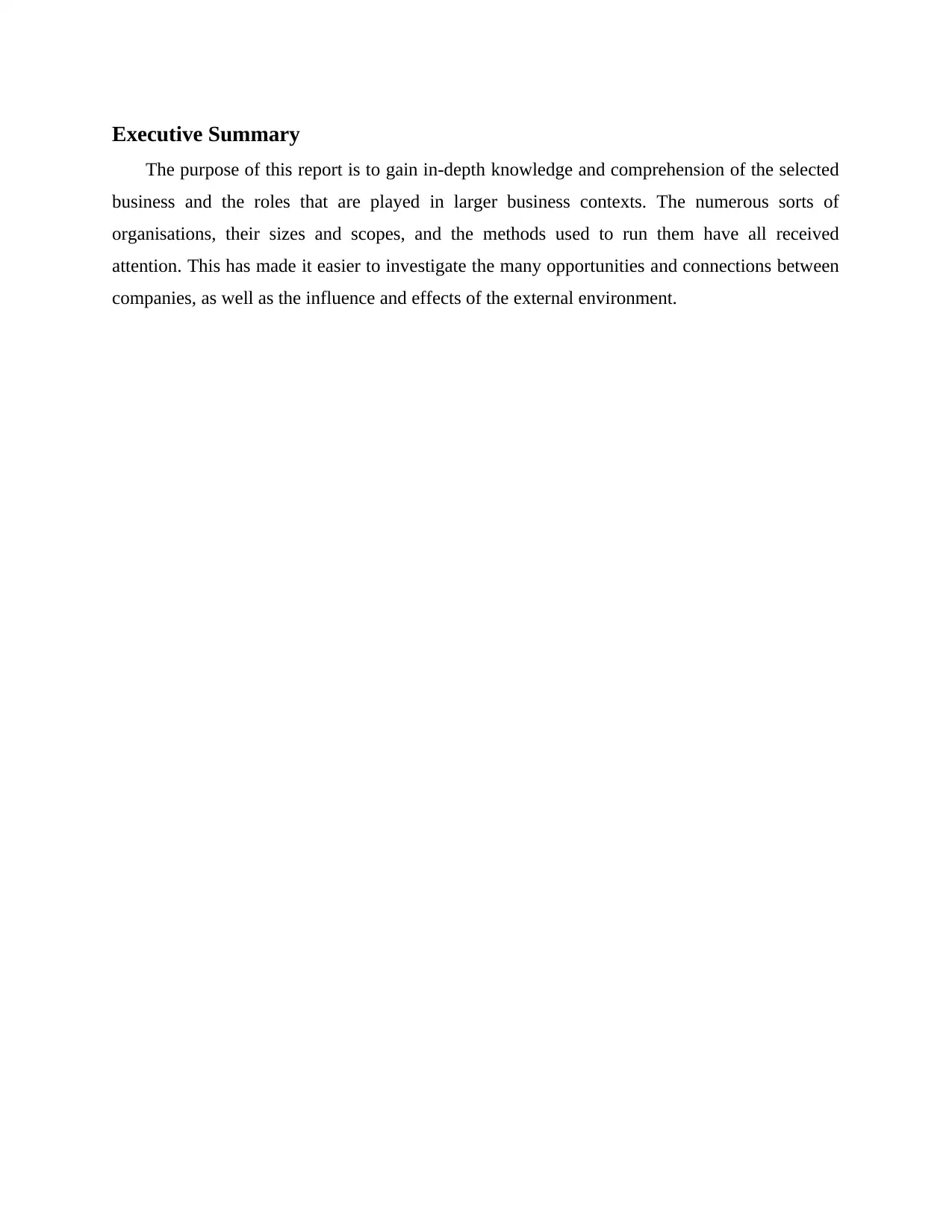
Executive Summary
The purpose of this report is to gain in-depth knowledge and comprehension of the selected
business and the roles that are played in larger business contexts. The numerous sorts of
organisations, their sizes and scopes, and the methods used to run them have all received
attention. This has made it easier to investigate the many opportunities and connections between
companies, as well as the influence and effects of the external environment.
The purpose of this report is to gain in-depth knowledge and comprehension of the selected
business and the roles that are played in larger business contexts. The numerous sorts of
organisations, their sizes and scopes, and the methods used to run them have all received
attention. This has made it easier to investigate the many opportunities and connections between
companies, as well as the influence and effects of the external environment.
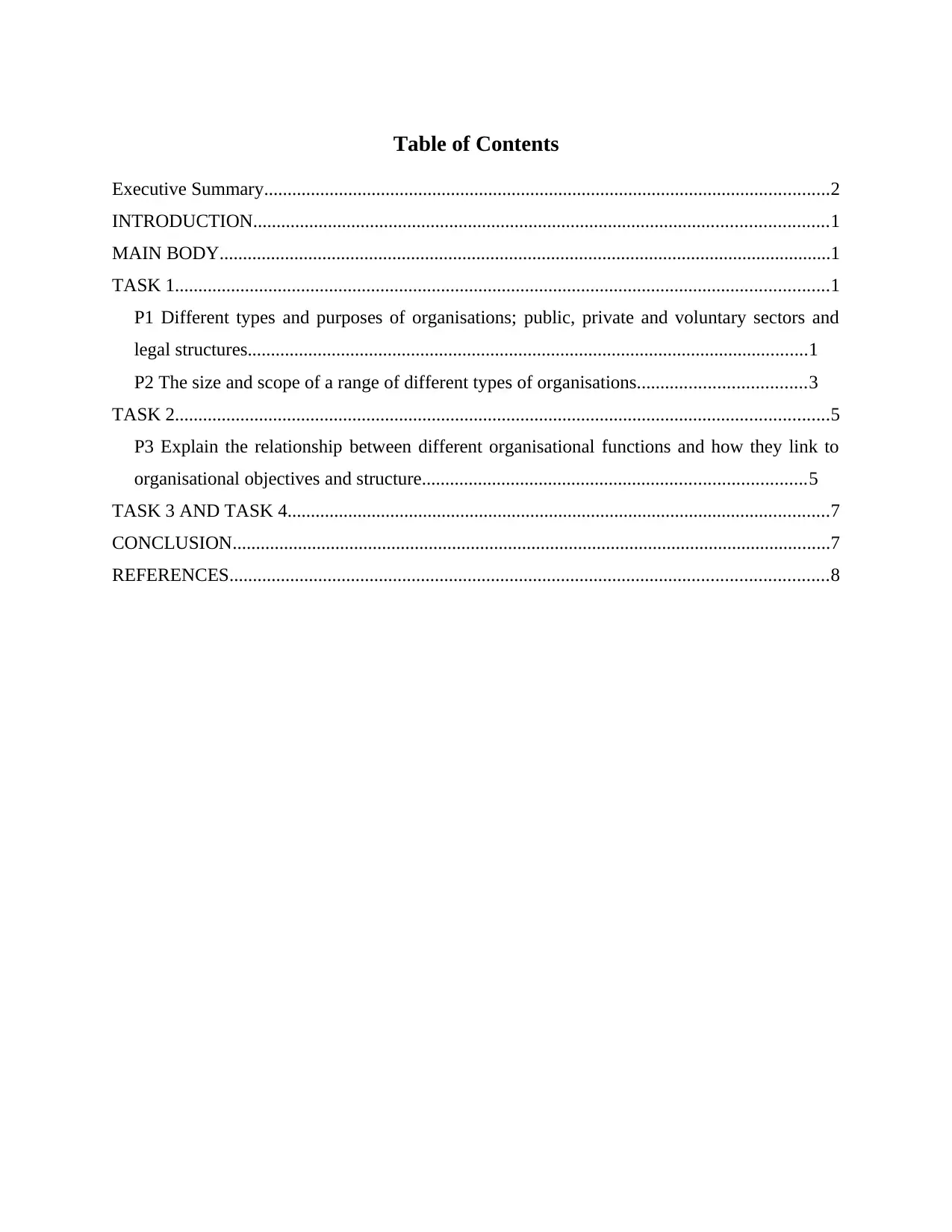
Table of Contents
Executive Summary.........................................................................................................................2
INTRODUCTION...........................................................................................................................1
MAIN BODY...................................................................................................................................1
TASK 1............................................................................................................................................1
P1 Different types and purposes of organisations; public, private and voluntary sectors and
legal structures........................................................................................................................1
P2 The size and scope of a range of different types of organisations....................................3
TASK 2............................................................................................................................................5
P3 Explain the relationship between different organisational functions and how they link to
organisational objectives and structure..................................................................................5
TASK 3 AND TASK 4....................................................................................................................7
CONCLUSION................................................................................................................................7
REFERENCES................................................................................................................................8
Executive Summary.........................................................................................................................2
INTRODUCTION...........................................................................................................................1
MAIN BODY...................................................................................................................................1
TASK 1............................................................................................................................................1
P1 Different types and purposes of organisations; public, private and voluntary sectors and
legal structures........................................................................................................................1
P2 The size and scope of a range of different types of organisations....................................3
TASK 2............................................................................................................................................5
P3 Explain the relationship between different organisational functions and how they link to
organisational objectives and structure..................................................................................5
TASK 3 AND TASK 4....................................................................................................................7
CONCLUSION................................................................................................................................7
REFERENCES................................................................................................................................8
⊘ This is a preview!⊘
Do you want full access?
Subscribe today to unlock all pages.

Trusted by 1+ million students worldwide
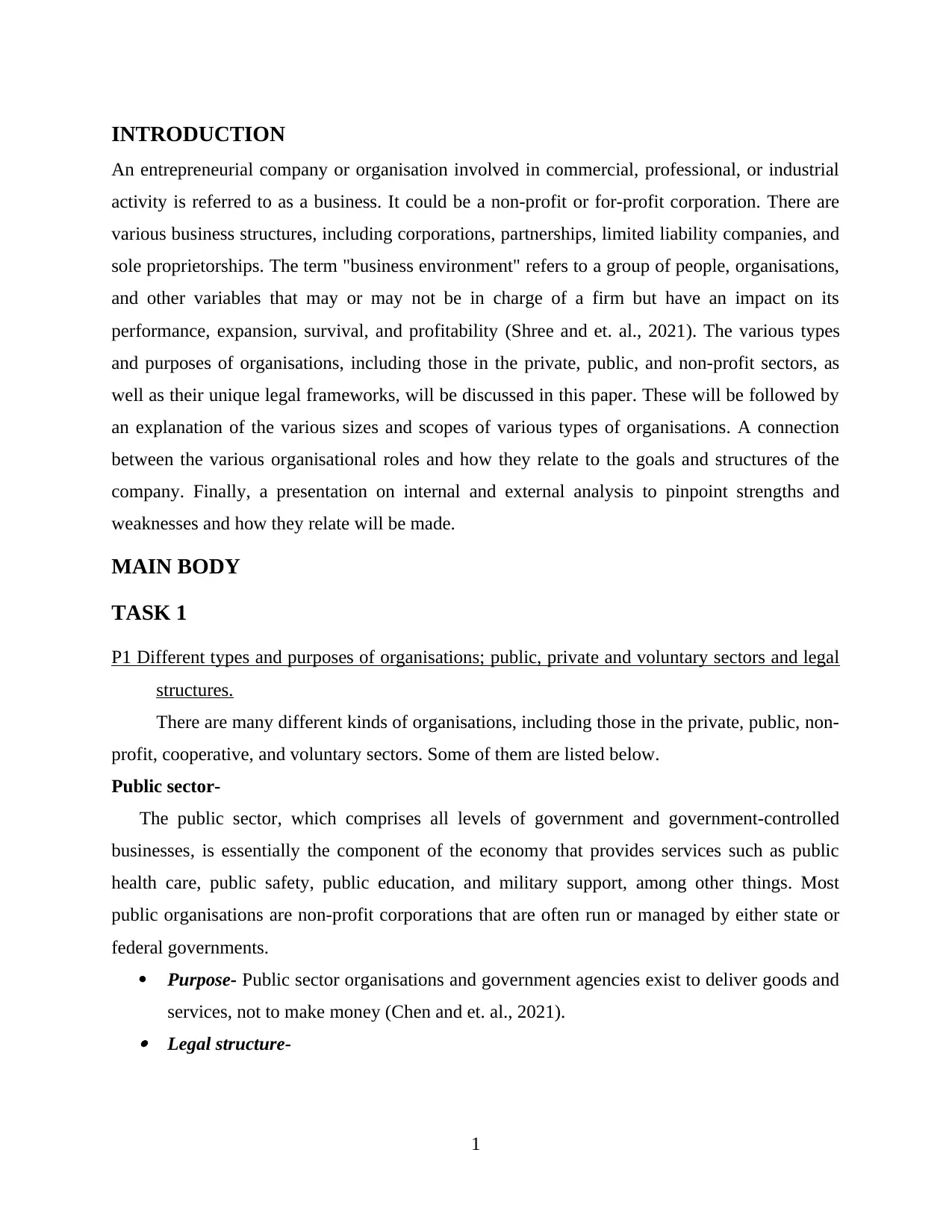
INTRODUCTION
An entrepreneurial company or organisation involved in commercial, professional, or industrial
activity is referred to as a business. It could be a non-profit or for-profit corporation. There are
various business structures, including corporations, partnerships, limited liability companies, and
sole proprietorships. The term "business environment" refers to a group of people, organisations,
and other variables that may or may not be in charge of a firm but have an impact on its
performance, expansion, survival, and profitability (Shree and et. al., 2021). The various types
and purposes of organisations, including those in the private, public, and non-profit sectors, as
well as their unique legal frameworks, will be discussed in this paper. These will be followed by
an explanation of the various sizes and scopes of various types of organisations. A connection
between the various organisational roles and how they relate to the goals and structures of the
company. Finally, a presentation on internal and external analysis to pinpoint strengths and
weaknesses and how they relate will be made.
MAIN BODY
TASK 1
P1 Different types and purposes of organisations; public, private and voluntary sectors and legal
structures.
There are many different kinds of organisations, including those in the private, public, non-
profit, cooperative, and voluntary sectors. Some of them are listed below.
Public sector-
The public sector, which comprises all levels of government and government-controlled
businesses, is essentially the component of the economy that provides services such as public
health care, public safety, public education, and military support, among other things. Most
public organisations are non-profit corporations that are often run or managed by either state or
federal governments.
Purpose- Public sector organisations and government agencies exist to deliver goods and
services, not to make money (Chen and et. al., 2021). Legal structure-
1
An entrepreneurial company or organisation involved in commercial, professional, or industrial
activity is referred to as a business. It could be a non-profit or for-profit corporation. There are
various business structures, including corporations, partnerships, limited liability companies, and
sole proprietorships. The term "business environment" refers to a group of people, organisations,
and other variables that may or may not be in charge of a firm but have an impact on its
performance, expansion, survival, and profitability (Shree and et. al., 2021). The various types
and purposes of organisations, including those in the private, public, and non-profit sectors, as
well as their unique legal frameworks, will be discussed in this paper. These will be followed by
an explanation of the various sizes and scopes of various types of organisations. A connection
between the various organisational roles and how they relate to the goals and structures of the
company. Finally, a presentation on internal and external analysis to pinpoint strengths and
weaknesses and how they relate will be made.
MAIN BODY
TASK 1
P1 Different types and purposes of organisations; public, private and voluntary sectors and legal
structures.
There are many different kinds of organisations, including those in the private, public, non-
profit, cooperative, and voluntary sectors. Some of them are listed below.
Public sector-
The public sector, which comprises all levels of government and government-controlled
businesses, is essentially the component of the economy that provides services such as public
health care, public safety, public education, and military support, among other things. Most
public organisations are non-profit corporations that are often run or managed by either state or
federal governments.
Purpose- Public sector organisations and government agencies exist to deliver goods and
services, not to make money (Chen and et. al., 2021). Legal structure-
1
Paraphrase This Document
Need a fresh take? Get an instant paraphrase of this document with our AI Paraphraser
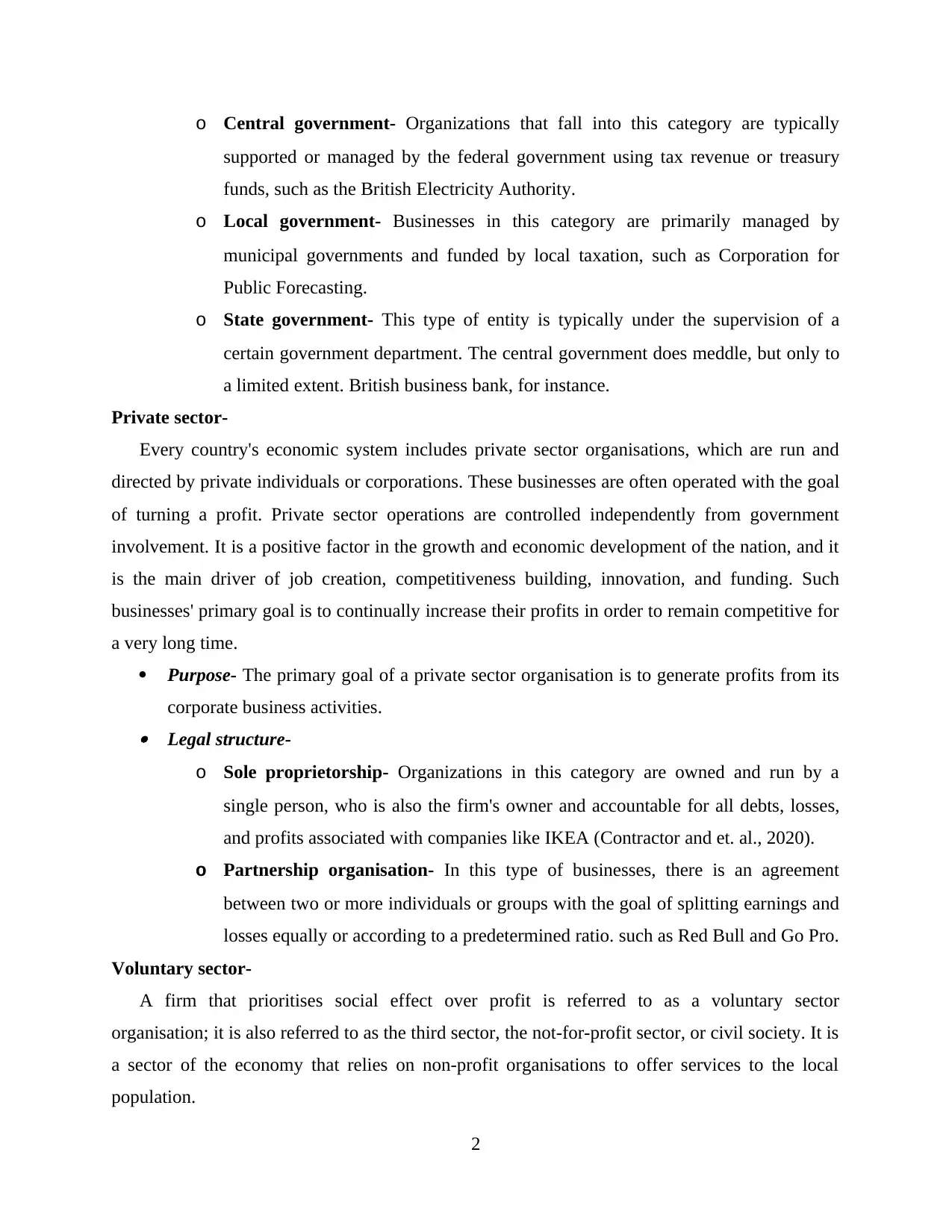
o Central government- Organizations that fall into this category are typically
supported or managed by the federal government using tax revenue or treasury
funds, such as the British Electricity Authority.
o Local government- Businesses in this category are primarily managed by
municipal governments and funded by local taxation, such as Corporation for
Public Forecasting.
o State government- This type of entity is typically under the supervision of a
certain government department. The central government does meddle, but only to
a limited extent. British business bank, for instance.
Private sector-
Every country's economic system includes private sector organisations, which are run and
directed by private individuals or corporations. These businesses are often operated with the goal
of turning a profit. Private sector operations are controlled independently from government
involvement. It is a positive factor in the growth and economic development of the nation, and it
is the main driver of job creation, competitiveness building, innovation, and funding. Such
businesses' primary goal is to continually increase their profits in order to remain competitive for
a very long time.
Purpose- The primary goal of a private sector organisation is to generate profits from its
corporate business activities. Legal structure-
o Sole proprietorship- Organizations in this category are owned and run by a
single person, who is also the firm's owner and accountable for all debts, losses,
and profits associated with companies like IKEA (Contractor and et. al., 2020).
o Partnership organisation- In this type of businesses, there is an agreement
between two or more individuals or groups with the goal of splitting earnings and
losses equally or according to a predetermined ratio. such as Red Bull and Go Pro.
Voluntary sector-
A firm that prioritises social effect over profit is referred to as a voluntary sector
organisation; it is also referred to as the third sector, the not-for-profit sector, or civil society. It is
a sector of the economy that relies on non-profit organisations to offer services to the local
population.
2
supported or managed by the federal government using tax revenue or treasury
funds, such as the British Electricity Authority.
o Local government- Businesses in this category are primarily managed by
municipal governments and funded by local taxation, such as Corporation for
Public Forecasting.
o State government- This type of entity is typically under the supervision of a
certain government department. The central government does meddle, but only to
a limited extent. British business bank, for instance.
Private sector-
Every country's economic system includes private sector organisations, which are run and
directed by private individuals or corporations. These businesses are often operated with the goal
of turning a profit. Private sector operations are controlled independently from government
involvement. It is a positive factor in the growth and economic development of the nation, and it
is the main driver of job creation, competitiveness building, innovation, and funding. Such
businesses' primary goal is to continually increase their profits in order to remain competitive for
a very long time.
Purpose- The primary goal of a private sector organisation is to generate profits from its
corporate business activities. Legal structure-
o Sole proprietorship- Organizations in this category are owned and run by a
single person, who is also the firm's owner and accountable for all debts, losses,
and profits associated with companies like IKEA (Contractor and et. al., 2020).
o Partnership organisation- In this type of businesses, there is an agreement
between two or more individuals or groups with the goal of splitting earnings and
losses equally or according to a predetermined ratio. such as Red Bull and Go Pro.
Voluntary sector-
A firm that prioritises social effect over profit is referred to as a voluntary sector
organisation; it is also referred to as the third sector, the not-for-profit sector, or civil society. It is
a sector of the economy that relies on non-profit organisations to offer services to the local
population.
2
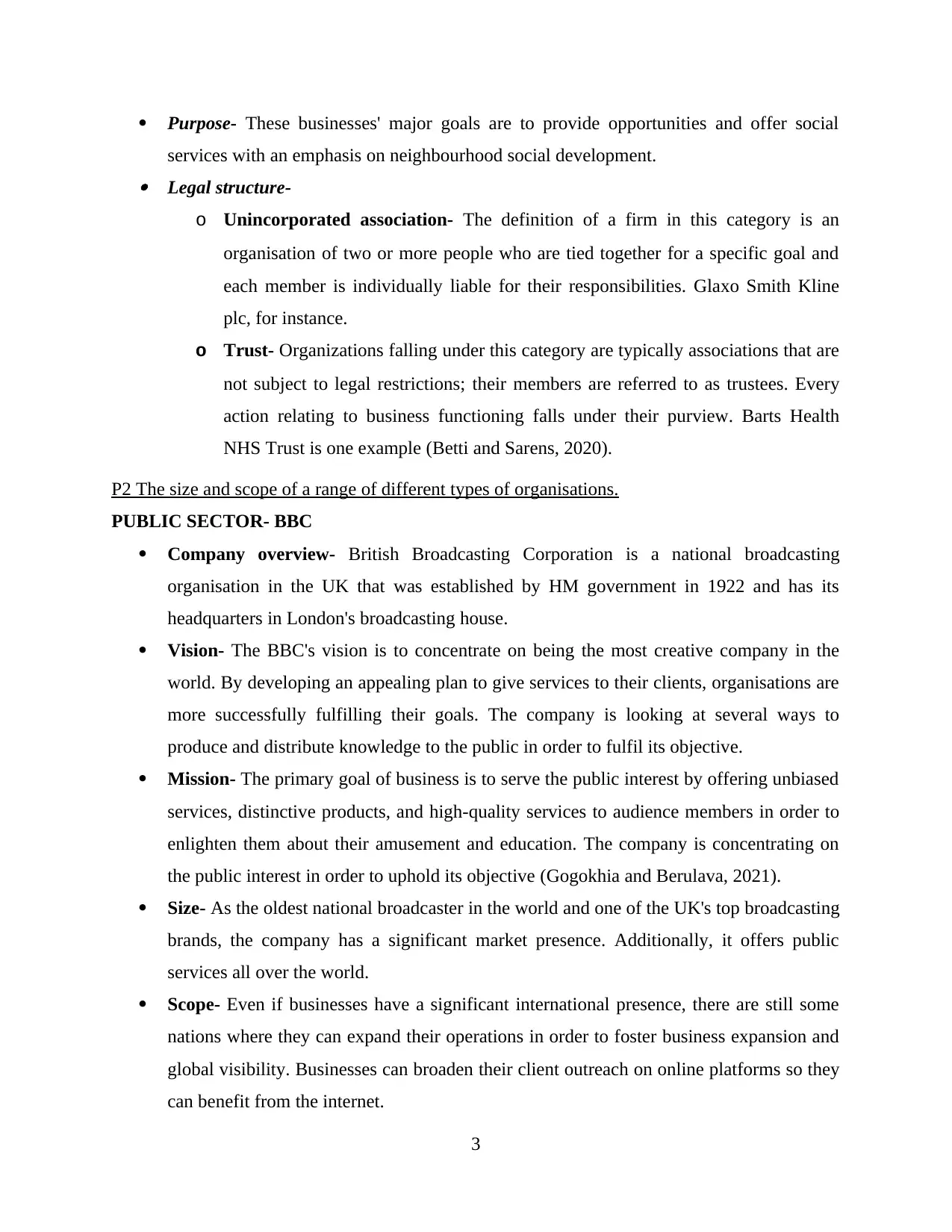
Purpose- These businesses' major goals are to provide opportunities and offer social
services with an emphasis on neighbourhood social development. Legal structure-
o Unincorporated association- The definition of a firm in this category is an
organisation of two or more people who are tied together for a specific goal and
each member is individually liable for their responsibilities. Glaxo Smith Kline
plc, for instance.
o Trust- Organizations falling under this category are typically associations that are
not subject to legal restrictions; their members are referred to as trustees. Every
action relating to business functioning falls under their purview. Barts Health
NHS Trust is one example (Betti and Sarens, 2020).
P2 The size and scope of a range of different types of organisations.
PUBLIC SECTOR- BBC
Company overview- British Broadcasting Corporation is a national broadcasting
organisation in the UK that was established by HM government in 1922 and has its
headquarters in London's broadcasting house.
Vision- The BBC's vision is to concentrate on being the most creative company in the
world. By developing an appealing plan to give services to their clients, organisations are
more successfully fulfilling their goals. The company is looking at several ways to
produce and distribute knowledge to the public in order to fulfil its objective.
Mission- The primary goal of business is to serve the public interest by offering unbiased
services, distinctive products, and high-quality services to audience members in order to
enlighten them about their amusement and education. The company is concentrating on
the public interest in order to uphold its objective (Gogokhia and Berulava, 2021).
Size- As the oldest national broadcaster in the world and one of the UK's top broadcasting
brands, the company has a significant market presence. Additionally, it offers public
services all over the world.
Scope- Even if businesses have a significant international presence, there are still some
nations where they can expand their operations in order to foster business expansion and
global visibility. Businesses can broaden their client outreach on online platforms so they
can benefit from the internet.
3
services with an emphasis on neighbourhood social development. Legal structure-
o Unincorporated association- The definition of a firm in this category is an
organisation of two or more people who are tied together for a specific goal and
each member is individually liable for their responsibilities. Glaxo Smith Kline
plc, for instance.
o Trust- Organizations falling under this category are typically associations that are
not subject to legal restrictions; their members are referred to as trustees. Every
action relating to business functioning falls under their purview. Barts Health
NHS Trust is one example (Betti and Sarens, 2020).
P2 The size and scope of a range of different types of organisations.
PUBLIC SECTOR- BBC
Company overview- British Broadcasting Corporation is a national broadcasting
organisation in the UK that was established by HM government in 1922 and has its
headquarters in London's broadcasting house.
Vision- The BBC's vision is to concentrate on being the most creative company in the
world. By developing an appealing plan to give services to their clients, organisations are
more successfully fulfilling their goals. The company is looking at several ways to
produce and distribute knowledge to the public in order to fulfil its objective.
Mission- The primary goal of business is to serve the public interest by offering unbiased
services, distinctive products, and high-quality services to audience members in order to
enlighten them about their amusement and education. The company is concentrating on
the public interest in order to uphold its objective (Gogokhia and Berulava, 2021).
Size- As the oldest national broadcaster in the world and one of the UK's top broadcasting
brands, the company has a significant market presence. Additionally, it offers public
services all over the world.
Scope- Even if businesses have a significant international presence, there are still some
nations where they can expand their operations in order to foster business expansion and
global visibility. Businesses can broaden their client outreach on online platforms so they
can benefit from the internet.
3
⊘ This is a preview!⊘
Do you want full access?
Subscribe today to unlock all pages.

Trusted by 1+ million students worldwide
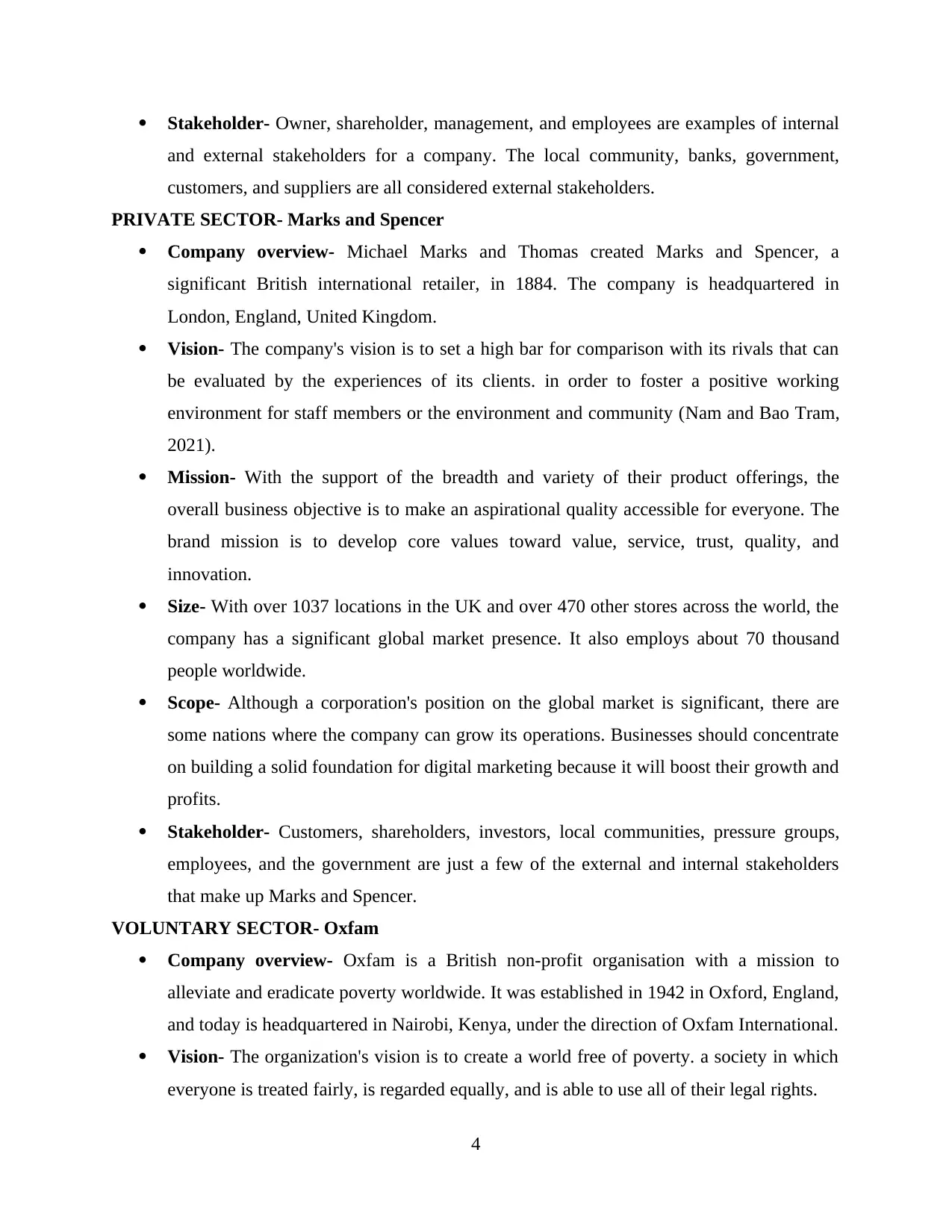
Stakeholder- Owner, shareholder, management, and employees are examples of internal
and external stakeholders for a company. The local community, banks, government,
customers, and suppliers are all considered external stakeholders.
PRIVATE SECTOR- Marks and Spencer
Company overview- Michael Marks and Thomas created Marks and Spencer, a
significant British international retailer, in 1884. The company is headquartered in
London, England, United Kingdom.
Vision- The company's vision is to set a high bar for comparison with its rivals that can
be evaluated by the experiences of its clients. in order to foster a positive working
environment for staff members or the environment and community (Nam and Bao Tram,
2021).
Mission- With the support of the breadth and variety of their product offerings, the
overall business objective is to make an aspirational quality accessible for everyone. The
brand mission is to develop core values toward value, service, trust, quality, and
innovation.
Size- With over 1037 locations in the UK and over 470 other stores across the world, the
company has a significant global market presence. It also employs about 70 thousand
people worldwide.
Scope- Although a corporation's position on the global market is significant, there are
some nations where the company can grow its operations. Businesses should concentrate
on building a solid foundation for digital marketing because it will boost their growth and
profits.
Stakeholder- Customers, shareholders, investors, local communities, pressure groups,
employees, and the government are just a few of the external and internal stakeholders
that make up Marks and Spencer.
VOLUNTARY SECTOR- Oxfam
Company overview- Oxfam is a British non-profit organisation with a mission to
alleviate and eradicate poverty worldwide. It was established in 1942 in Oxford, England,
and today is headquartered in Nairobi, Kenya, under the direction of Oxfam International.
Vision- The organization's vision is to create a world free of poverty. a society in which
everyone is treated fairly, is regarded equally, and is able to use all of their legal rights.
4
and external stakeholders for a company. The local community, banks, government,
customers, and suppliers are all considered external stakeholders.
PRIVATE SECTOR- Marks and Spencer
Company overview- Michael Marks and Thomas created Marks and Spencer, a
significant British international retailer, in 1884. The company is headquartered in
London, England, United Kingdom.
Vision- The company's vision is to set a high bar for comparison with its rivals that can
be evaluated by the experiences of its clients. in order to foster a positive working
environment for staff members or the environment and community (Nam and Bao Tram,
2021).
Mission- With the support of the breadth and variety of their product offerings, the
overall business objective is to make an aspirational quality accessible for everyone. The
brand mission is to develop core values toward value, service, trust, quality, and
innovation.
Size- With over 1037 locations in the UK and over 470 other stores across the world, the
company has a significant global market presence. It also employs about 70 thousand
people worldwide.
Scope- Although a corporation's position on the global market is significant, there are
some nations where the company can grow its operations. Businesses should concentrate
on building a solid foundation for digital marketing because it will boost their growth and
profits.
Stakeholder- Customers, shareholders, investors, local communities, pressure groups,
employees, and the government are just a few of the external and internal stakeholders
that make up Marks and Spencer.
VOLUNTARY SECTOR- Oxfam
Company overview- Oxfam is a British non-profit organisation with a mission to
alleviate and eradicate poverty worldwide. It was established in 1942 in Oxford, England,
and today is headquartered in Nairobi, Kenya, under the direction of Oxfam International.
Vision- The organization's vision is to create a world free of poverty. a society in which
everyone is treated fairly, is regarded equally, and is able to use all of their legal rights.
4
Paraphrase This Document
Need a fresh take? Get an instant paraphrase of this document with our AI Paraphraser
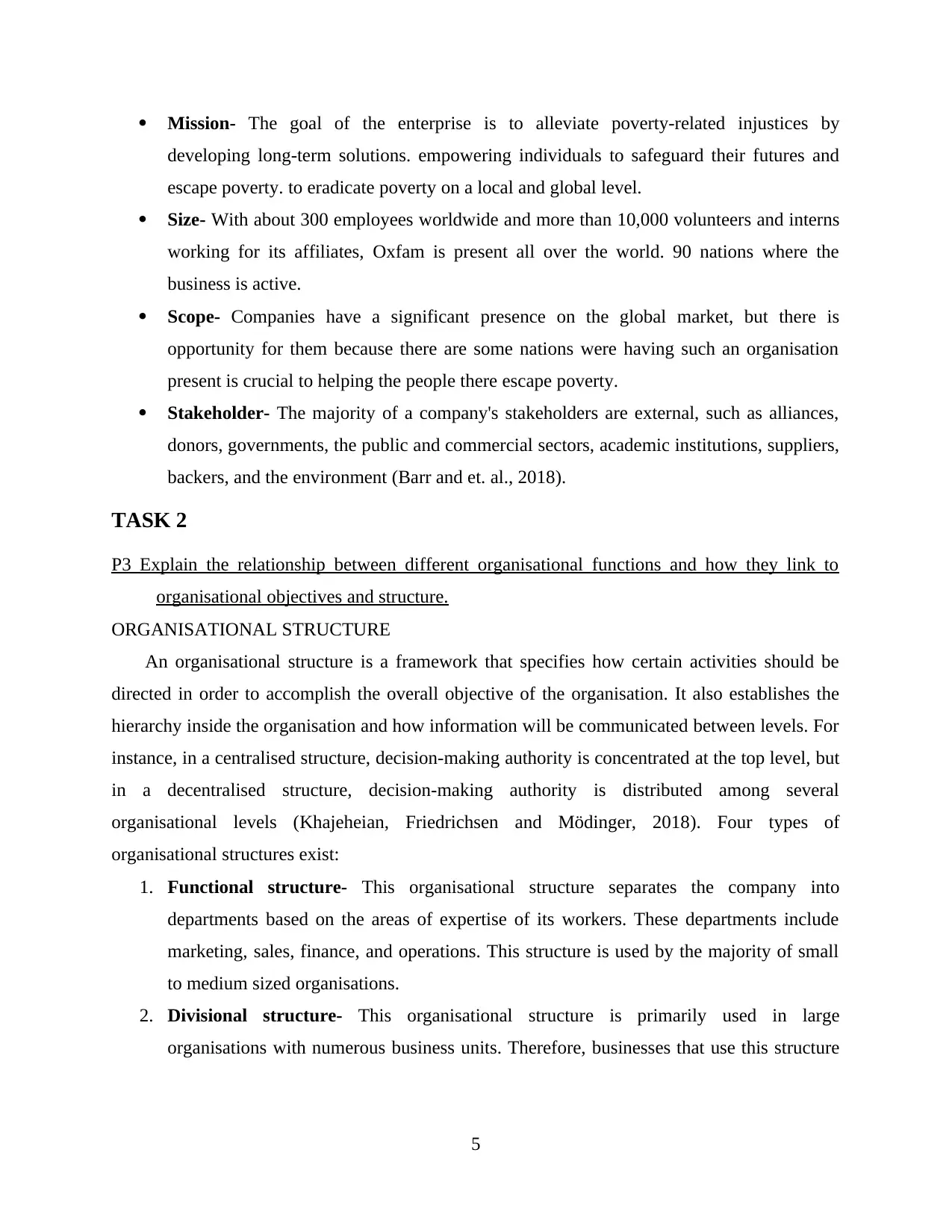
Mission- The goal of the enterprise is to alleviate poverty-related injustices by
developing long-term solutions. empowering individuals to safeguard their futures and
escape poverty. to eradicate poverty on a local and global level.
Size- With about 300 employees worldwide and more than 10,000 volunteers and interns
working for its affiliates, Oxfam is present all over the world. 90 nations where the
business is active.
Scope- Companies have a significant presence on the global market, but there is
opportunity for them because there are some nations were having such an organisation
present is crucial to helping the people there escape poverty.
Stakeholder- The majority of a company's stakeholders are external, such as alliances,
donors, governments, the public and commercial sectors, academic institutions, suppliers,
backers, and the environment (Barr and et. al., 2018).
TASK 2
P3 Explain the relationship between different organisational functions and how they link to
organisational objectives and structure.
ORGANISATIONAL STRUCTURE
An organisational structure is a framework that specifies how certain activities should be
directed in order to accomplish the overall objective of the organisation. It also establishes the
hierarchy inside the organisation and how information will be communicated between levels. For
instance, in a centralised structure, decision-making authority is concentrated at the top level, but
in a decentralised structure, decision-making authority is distributed among several
organisational levels (Khajeheian, Friedrichsen and Mödinger, 2018). Four types of
organisational structures exist:
1. Functional structure- This organisational structure separates the company into
departments based on the areas of expertise of its workers. These departments include
marketing, sales, finance, and operations. This structure is used by the majority of small
to medium sized organisations.
2. Divisional structure- This organisational structure is primarily used in large
organisations with numerous business units. Therefore, businesses that use this structure
5
developing long-term solutions. empowering individuals to safeguard their futures and
escape poverty. to eradicate poverty on a local and global level.
Size- With about 300 employees worldwide and more than 10,000 volunteers and interns
working for its affiliates, Oxfam is present all over the world. 90 nations where the
business is active.
Scope- Companies have a significant presence on the global market, but there is
opportunity for them because there are some nations were having such an organisation
present is crucial to helping the people there escape poverty.
Stakeholder- The majority of a company's stakeholders are external, such as alliances,
donors, governments, the public and commercial sectors, academic institutions, suppliers,
backers, and the environment (Barr and et. al., 2018).
TASK 2
P3 Explain the relationship between different organisational functions and how they link to
organisational objectives and structure.
ORGANISATIONAL STRUCTURE
An organisational structure is a framework that specifies how certain activities should be
directed in order to accomplish the overall objective of the organisation. It also establishes the
hierarchy inside the organisation and how information will be communicated between levels. For
instance, in a centralised structure, decision-making authority is concentrated at the top level, but
in a decentralised structure, decision-making authority is distributed among several
organisational levels (Khajeheian, Friedrichsen and Mödinger, 2018). Four types of
organisational structures exist:
1. Functional structure- This organisational structure separates the company into
departments based on the areas of expertise of its workers. These departments include
marketing, sales, finance, and operations. This structure is used by the majority of small
to medium sized organisations.
2. Divisional structure- This organisational structure is primarily used in large
organisations with numerous business units. Therefore, businesses that use this structure
5
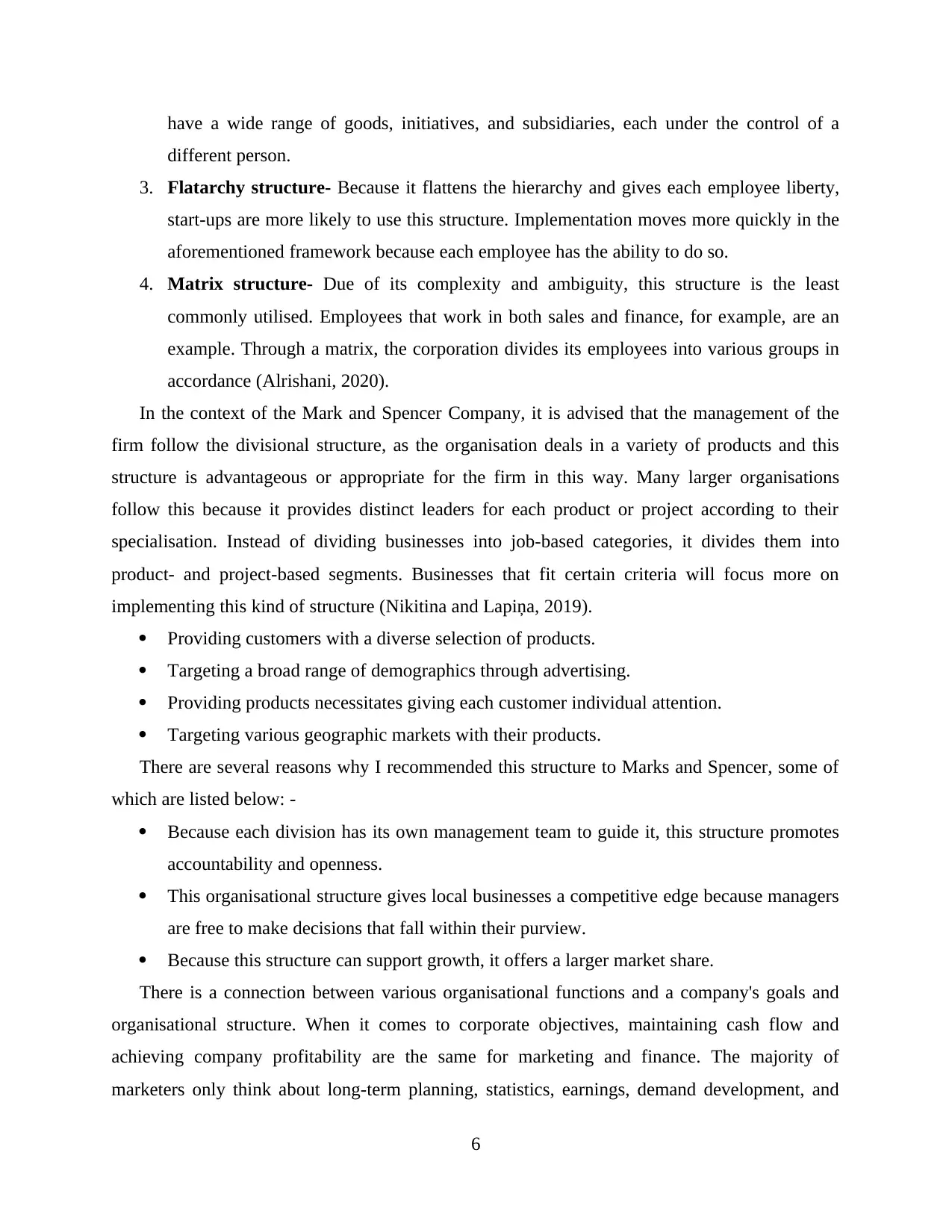
have a wide range of goods, initiatives, and subsidiaries, each under the control of a
different person.
3. Flatarchy structure- Because it flattens the hierarchy and gives each employee liberty,
start-ups are more likely to use this structure. Implementation moves more quickly in the
aforementioned framework because each employee has the ability to do so.
4. Matrix structure- Due of its complexity and ambiguity, this structure is the least
commonly utilised. Employees that work in both sales and finance, for example, are an
example. Through a matrix, the corporation divides its employees into various groups in
accordance (Alrishani, 2020).
In the context of the Mark and Spencer Company, it is advised that the management of the
firm follow the divisional structure, as the organisation deals in a variety of products and this
structure is advantageous or appropriate for the firm in this way. Many larger organisations
follow this because it provides distinct leaders for each product or project according to their
specialisation. Instead of dividing businesses into job-based categories, it divides them into
product- and project-based segments. Businesses that fit certain criteria will focus more on
implementing this kind of structure (Nikitina and Lapiņa, 2019).
Providing customers with a diverse selection of products.
Targeting a broad range of demographics through advertising.
Providing products necessitates giving each customer individual attention.
Targeting various geographic markets with their products.
There are several reasons why I recommended this structure to Marks and Spencer, some of
which are listed below: -
Because each division has its own management team to guide it, this structure promotes
accountability and openness.
This organisational structure gives local businesses a competitive edge because managers
are free to make decisions that fall within their purview.
Because this structure can support growth, it offers a larger market share.
There is a connection between various organisational functions and a company's goals and
organisational structure. When it comes to corporate objectives, maintaining cash flow and
achieving company profitability are the same for marketing and finance. The majority of
marketers only think about long-term planning, statistics, earnings, demand development, and
6
different person.
3. Flatarchy structure- Because it flattens the hierarchy and gives each employee liberty,
start-ups are more likely to use this structure. Implementation moves more quickly in the
aforementioned framework because each employee has the ability to do so.
4. Matrix structure- Due of its complexity and ambiguity, this structure is the least
commonly utilised. Employees that work in both sales and finance, for example, are an
example. Through a matrix, the corporation divides its employees into various groups in
accordance (Alrishani, 2020).
In the context of the Mark and Spencer Company, it is advised that the management of the
firm follow the divisional structure, as the organisation deals in a variety of products and this
structure is advantageous or appropriate for the firm in this way. Many larger organisations
follow this because it provides distinct leaders for each product or project according to their
specialisation. Instead of dividing businesses into job-based categories, it divides them into
product- and project-based segments. Businesses that fit certain criteria will focus more on
implementing this kind of structure (Nikitina and Lapiņa, 2019).
Providing customers with a diverse selection of products.
Targeting a broad range of demographics through advertising.
Providing products necessitates giving each customer individual attention.
Targeting various geographic markets with their products.
There are several reasons why I recommended this structure to Marks and Spencer, some of
which are listed below: -
Because each division has its own management team to guide it, this structure promotes
accountability and openness.
This organisational structure gives local businesses a competitive edge because managers
are free to make decisions that fall within their purview.
Because this structure can support growth, it offers a larger market share.
There is a connection between various organisational functions and a company's goals and
organisational structure. When it comes to corporate objectives, maintaining cash flow and
achieving company profitability are the same for marketing and finance. The majority of
marketers only think about long-term planning, statistics, earnings, demand development, and
6
⊘ This is a preview!⊘
Do you want full access?
Subscribe today to unlock all pages.

Trusted by 1+ million students worldwide
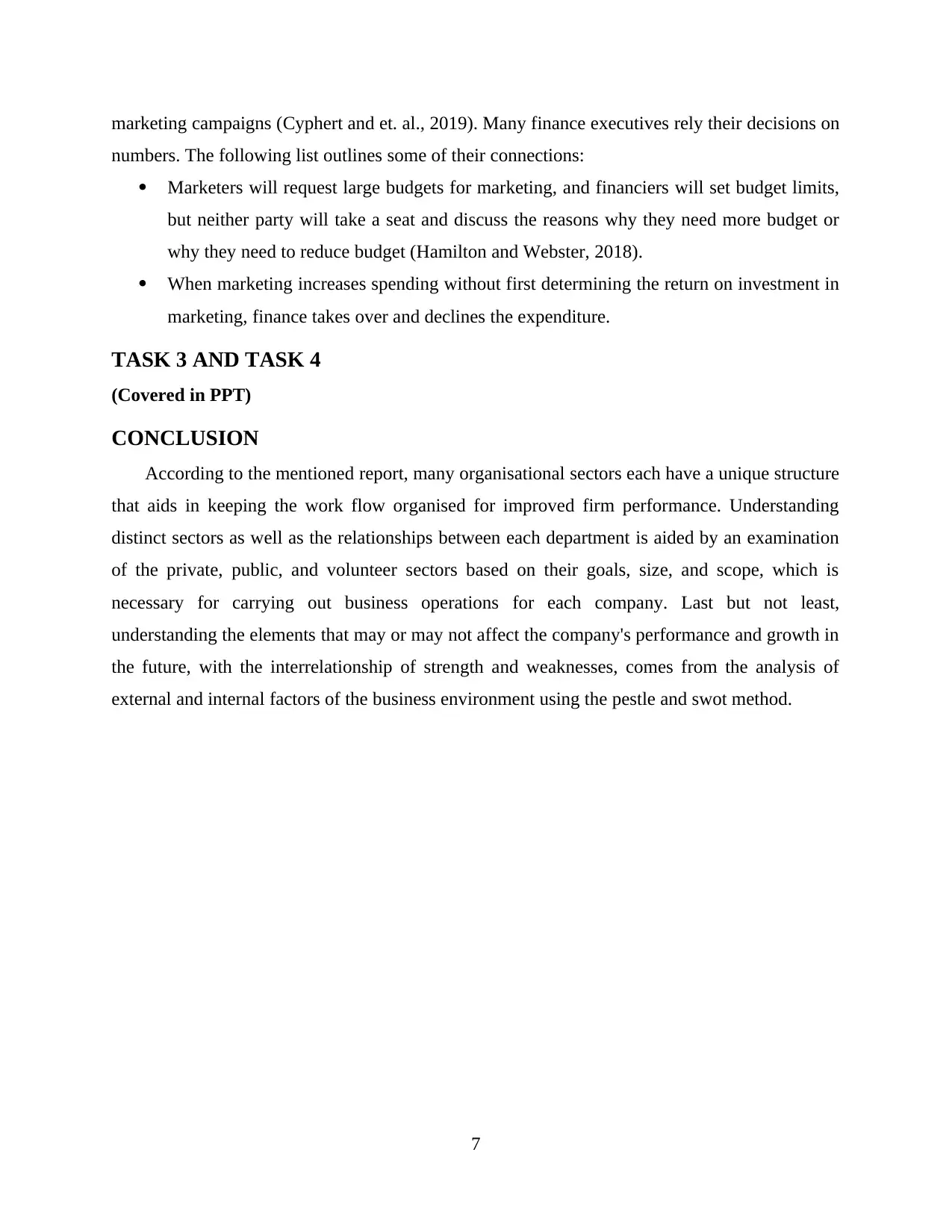
marketing campaigns (Cyphert and et. al., 2019). Many finance executives rely their decisions on
numbers. The following list outlines some of their connections:
Marketers will request large budgets for marketing, and financiers will set budget limits,
but neither party will take a seat and discuss the reasons why they need more budget or
why they need to reduce budget (Hamilton and Webster, 2018).
When marketing increases spending without first determining the return on investment in
marketing, finance takes over and declines the expenditure.
TASK 3 AND TASK 4
(Covered in PPT)
CONCLUSION
According to the mentioned report, many organisational sectors each have a unique structure
that aids in keeping the work flow organised for improved firm performance. Understanding
distinct sectors as well as the relationships between each department is aided by an examination
of the private, public, and volunteer sectors based on their goals, size, and scope, which is
necessary for carrying out business operations for each company. Last but not least,
understanding the elements that may or may not affect the company's performance and growth in
the future, with the interrelationship of strength and weaknesses, comes from the analysis of
external and internal factors of the business environment using the pestle and swot method.
7
numbers. The following list outlines some of their connections:
Marketers will request large budgets for marketing, and financiers will set budget limits,
but neither party will take a seat and discuss the reasons why they need more budget or
why they need to reduce budget (Hamilton and Webster, 2018).
When marketing increases spending without first determining the return on investment in
marketing, finance takes over and declines the expenditure.
TASK 3 AND TASK 4
(Covered in PPT)
CONCLUSION
According to the mentioned report, many organisational sectors each have a unique structure
that aids in keeping the work flow organised for improved firm performance. Understanding
distinct sectors as well as the relationships between each department is aided by an examination
of the private, public, and volunteer sectors based on their goals, size, and scope, which is
necessary for carrying out business operations for each company. Last but not least,
understanding the elements that may or may not affect the company's performance and growth in
the future, with the interrelationship of strength and weaknesses, comes from the analysis of
external and internal factors of the business environment using the pestle and swot method.
7
Paraphrase This Document
Need a fresh take? Get an instant paraphrase of this document with our AI Paraphraser
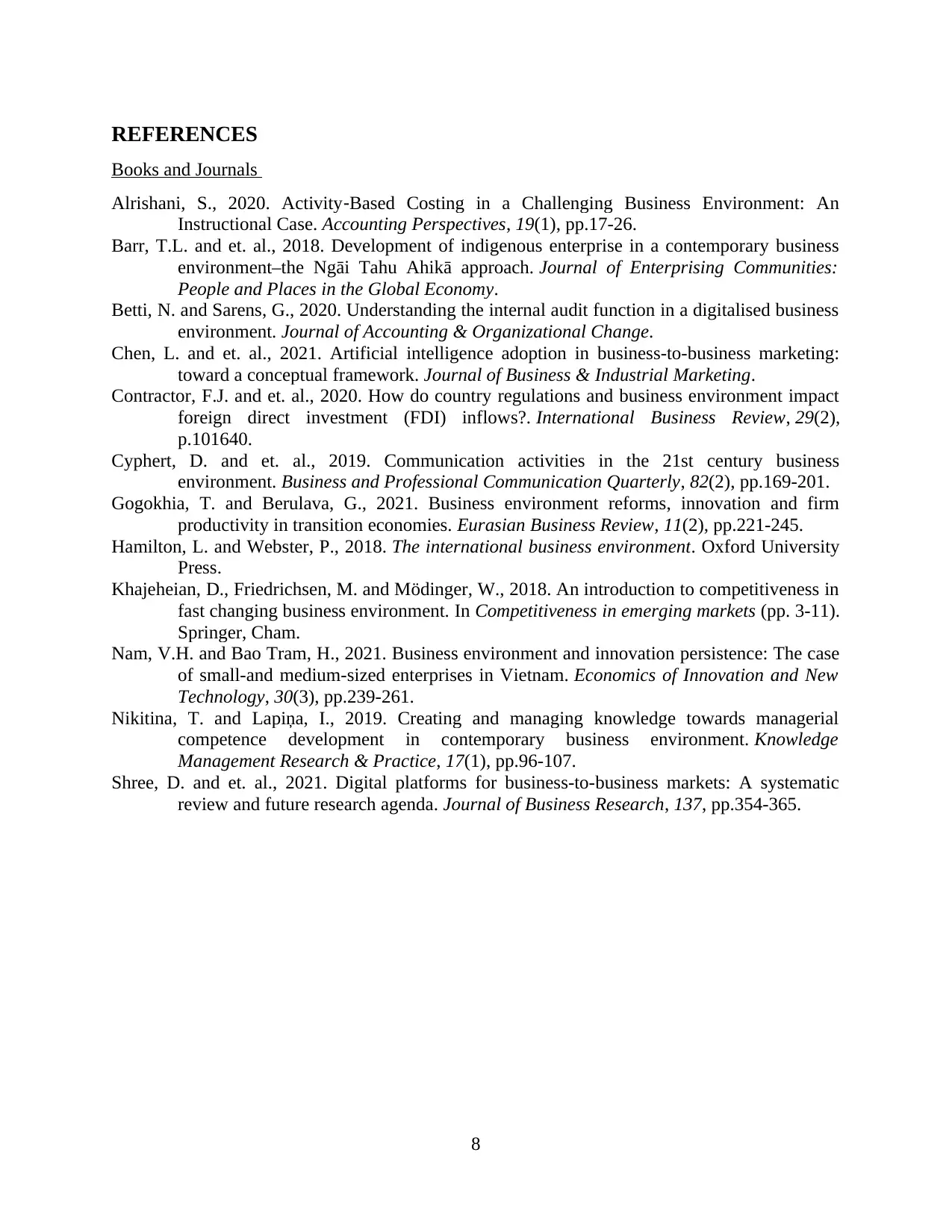
REFERENCES
Books and Journals
Alrishani, S., 2020. Activity‐Based Costing in a Challenging Business Environment: An
Instructional Case. Accounting Perspectives, 19(1), pp.17-26.
Barr, T.L. and et. al., 2018. Development of indigenous enterprise in a contemporary business
environment–the Ngāi Tahu Ahikā approach. Journal of Enterprising Communities:
People and Places in the Global Economy.
Betti, N. and Sarens, G., 2020. Understanding the internal audit function in a digitalised business
environment. Journal of Accounting & Organizational Change.
Chen, L. and et. al., 2021. Artificial intelligence adoption in business-to-business marketing:
toward a conceptual framework. Journal of Business & Industrial Marketing.
Contractor, F.J. and et. al., 2020. How do country regulations and business environment impact
foreign direct investment (FDI) inflows?. International Business Review, 29(2),
p.101640.
Cyphert, D. and et. al., 2019. Communication activities in the 21st century business
environment. Business and Professional Communication Quarterly, 82(2), pp.169-201.
Gogokhia, T. and Berulava, G., 2021. Business environment reforms, innovation and firm
productivity in transition economies. Eurasian Business Review, 11(2), pp.221-245.
Hamilton, L. and Webster, P., 2018. The international business environment. Oxford University
Press.
Khajeheian, D., Friedrichsen, M. and Mödinger, W., 2018. An introduction to competitiveness in
fast changing business environment. In Competitiveness in emerging markets (pp. 3-11).
Springer, Cham.
Nam, V.H. and Bao Tram, H., 2021. Business environment and innovation persistence: The case
of small-and medium-sized enterprises in Vietnam. Economics of Innovation and New
Technology, 30(3), pp.239-261.
Nikitina, T. and Lapiņa, I., 2019. Creating and managing knowledge towards managerial
competence development in contemporary business environment. Knowledge
Management Research & Practice, 17(1), pp.96-107.
Shree, D. and et. al., 2021. Digital platforms for business-to-business markets: A systematic
review and future research agenda. Journal of Business Research, 137, pp.354-365.
8
Books and Journals
Alrishani, S., 2020. Activity‐Based Costing in a Challenging Business Environment: An
Instructional Case. Accounting Perspectives, 19(1), pp.17-26.
Barr, T.L. and et. al., 2018. Development of indigenous enterprise in a contemporary business
environment–the Ngāi Tahu Ahikā approach. Journal of Enterprising Communities:
People and Places in the Global Economy.
Betti, N. and Sarens, G., 2020. Understanding the internal audit function in a digitalised business
environment. Journal of Accounting & Organizational Change.
Chen, L. and et. al., 2021. Artificial intelligence adoption in business-to-business marketing:
toward a conceptual framework. Journal of Business & Industrial Marketing.
Contractor, F.J. and et. al., 2020. How do country regulations and business environment impact
foreign direct investment (FDI) inflows?. International Business Review, 29(2),
p.101640.
Cyphert, D. and et. al., 2019. Communication activities in the 21st century business
environment. Business and Professional Communication Quarterly, 82(2), pp.169-201.
Gogokhia, T. and Berulava, G., 2021. Business environment reforms, innovation and firm
productivity in transition economies. Eurasian Business Review, 11(2), pp.221-245.
Hamilton, L. and Webster, P., 2018. The international business environment. Oxford University
Press.
Khajeheian, D., Friedrichsen, M. and Mödinger, W., 2018. An introduction to competitiveness in
fast changing business environment. In Competitiveness in emerging markets (pp. 3-11).
Springer, Cham.
Nam, V.H. and Bao Tram, H., 2021. Business environment and innovation persistence: The case
of small-and medium-sized enterprises in Vietnam. Economics of Innovation and New
Technology, 30(3), pp.239-261.
Nikitina, T. and Lapiņa, I., 2019. Creating and managing knowledge towards managerial
competence development in contemporary business environment. Knowledge
Management Research & Practice, 17(1), pp.96-107.
Shree, D. and et. al., 2021. Digital platforms for business-to-business markets: A systematic
review and future research agenda. Journal of Business Research, 137, pp.354-365.
8
1 out of 11
Related Documents
Your All-in-One AI-Powered Toolkit for Academic Success.
+13062052269
info@desklib.com
Available 24*7 on WhatsApp / Email
![[object Object]](/_next/static/media/star-bottom.7253800d.svg)
Unlock your academic potential
Copyright © 2020–2025 A2Z Services. All Rights Reserved. Developed and managed by ZUCOL.




